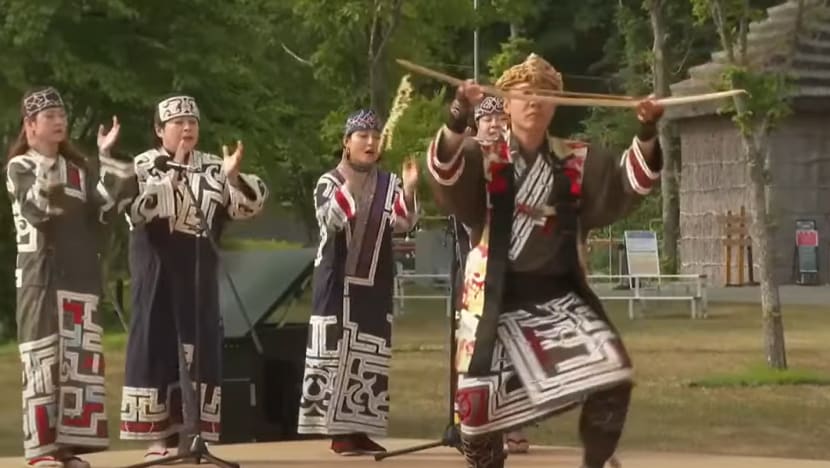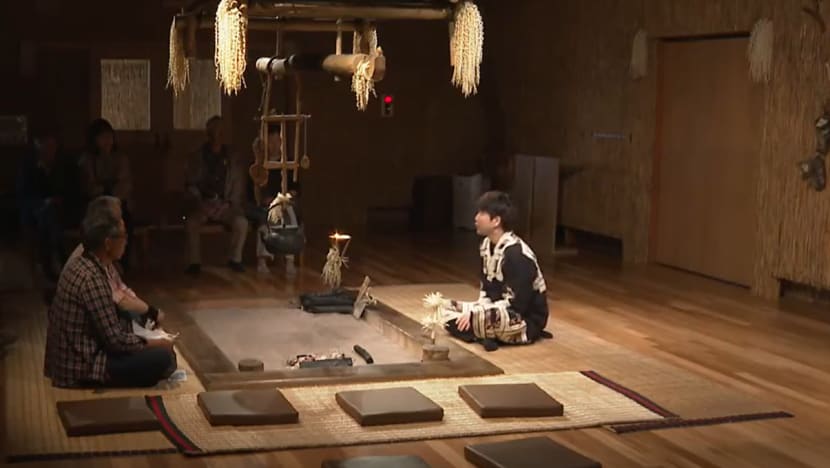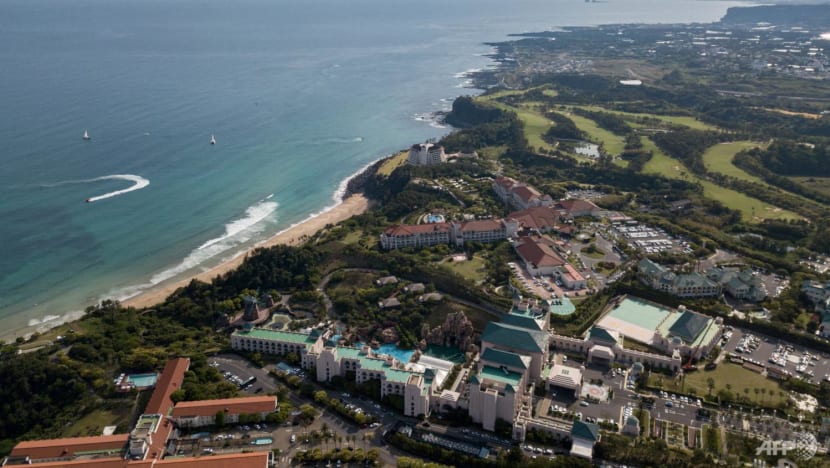What Japan and South Korea are doing to prevent their dying languages from vanishing forever
The two nations are trying to give a new lease of life to languages on the brink of extinction, but it remains to be seen if these efforts will bear fruit.

Ainu language teacher Kenyu Yamamaru telling students about Ainu greetings in Hokkaido, Japan (L), and a sign in the Jeju-eo language at a bridge on Jeju island, South Korea (R).

This audio is generated by an AI tool.
HOKKAIDO / JEJU: The label of being Ainu haunted Miyuki Muraki throughout her childhood.
“Since I was a child, I was called Ainu and bullied,” the 64-year-old said. “Because of that, there was a period when I hated the word ‘Ainu’.”
The ethnic group, who are indigenous to the lands of northern Japan and were the earliest settlers of Hokkaido, have been suppressed for decades. The Meiji government outlawed their customs and traditions in the late 19th century.
While Japan is now spending millions of dollars to support the Ainu people and their culture, fears of discrimination remain, causing some like Muraki to stop speaking the Ainu language altogether.
Her workplace, the National Ainu Museum and Park – also called Upopoy, an Ainu term for "let’s sing" – has been trying to revive the dying language, which has been designated as critically endangered by UNESCO.
Meanwhile, nearly 2,000km away, South Korea’s largest island of Jeju is also attempting to reverse the decline of its language.
Once an inseparable part of the volcanic island's identity, the Jeju-eo language was similarly designated as critically endangered in 2010 and has largely been replaced with standard Korean.
But public curiosity is helping to drive a revival of sorts. Jeju-eo has also found an unlikely ally in social media, where it is gaining a growing following.
CHALLENGES IN PASSING DOWN AINU
For the Ainu, many hide their identity and never tell their children about their roots even today.
Experts think they are descendants of the Jomon people, who inhabited Japan around 11,000 to 6,000 BC. They settled in Hokkaido and the north of Honshu island, as well as the Kuril Islands and Sakhalin.
Scholars said it is unclear how big the Ainu population is. While the Ainu Association conducts a survey every seven years among those in Hokkaido, analysts believe the numbers are an underestimate.
In 2017, the number stood at 13,118 – about 3,700 fewer compared with seven years before.
The Ainu language has also proven challenging to pass down due to a lack of written form and how it has split into several regional dialects.
In efforts to make up for the past, Japan is now pouring millions of dollars into reviving Ainu, including establishing the National Ainu Museum. The attraction has drawn more than a million visitors since it opened in 2020.

The museum holds activities to promote the Ainu language. Signboards there are written in Japanese characters that match Ainu phonetics, while new vocabulary has been created using loan words for terms that do not exist in Ainu.
Ainu language teacher Kenyu Yamamaru, who works at the museum in Hokkaido’s Shiraoi town, said he was able to take Ainu language classes as a child and never faced much discrimination.
“But I did hear from older people in Shiraoi who are not my relatives that they were bullied in school,” he added.
Yamamaru, who dropped out of high school, turned his life around when his late father – an advocate for Ainu culture – suggested he take up a three-year course for Ainu on their heritage.
In a cruel twist of fate, the older Yamamaru abruptly died of a heart attack before seeing the change in his son.
The 30-year-old can now perform pieces from the Ainu’s ancient storytelling tradition called yukar, which he learned from a recording left behind by his grandfather.

ANNOUNCEMENTS IN AINU
Apart from Shiraoi, the island of Hokkaido in general is starting to awaken to its roots.
For example, a staff shuttle at Hokkaido University in Sapporo began running announcements in Ainu in January.
The idea was inspired by a similar programme in another Hokkaido town, Biratori, and is driving up interest in the language.
But experts said these moves cannot reverse a history of forced assimilation, with Ainu like Yamamaru who embrace their identity remaining an exception.
"Even today, Japanese is the only national language taught. The culture and language of a minority do not see the light,” said Muraki, who knows some Ainu words but cannot hold a conversation in the language.
Beyond a flashy showcase, the experts said what the Ainu need is for the public to be informed about the dark truth of discrimination, as well as a space where they can live without prejudice and reclaim their language and identity.
“SEA WOMEN” AMONG LAST SPEAKERS OF JEJU-EO
Over in South Korea, reports have put the number of remaining Jeju-eo native speakers left in Jeju at a maximum of 10,000.
Nevertheless, the Jeju Dialect Institute thinks there could be as many as 40,000. Its researchers conduct and record interviews in Jeju-eo with the elderly every week.
While both Jeju-eo and the standard Korean language descended from the Korean alphabet Hangul, which was created in the 15th century, they evolved very differently.
As connectivity improved, Jeju islanders began to learn Korean. They now mostly speak standard Korean with a bit of Jeju-eo vocabulary.
Jeju, located almost 500km south of Seoul, developed its own traditions distinct from the rest of Korea due to its isolation – like the haenyo or “sea women” who are among the last remaining speakers of Jeju-eo.
The first records of the haenyo date back to the 17th century. Many men died at sea then, and women took over as breadwinners.
Today, the women – who are mostly elderly - are among the last remaining speakers of Jeju-eo.
"A lot of the language has disappeared. Even my grandchildren don’t know the Jeju language,” said 78-year-old haenyo Lee Jung-hee.
“They cannot speak the language well, but I think they can understand. They can understand what we grandmothers are saying.”

EFFORTS TO KEEP JEJU-EO ALIVE
There are those like YouTuber Kim Hong-gyu – who hails from Jeju – are doing their best to keep it alive.
The 29-year-old goes around the island talking to elderly people about their childhood and everyday things in Jeju-eo. He said his channel took off after he began posting videos about the language.
"I used the Jeju language as content once. People really liked it, and as I was doing it, they were leaving comments and reactions,” he told CNA.
“People were very disappointed to hear that the Jeju language could be extinct soon.”

The videos Kim takes are invaluable records of the fading language for the next generation, where much of the efforts to keep Jeju-eo alive are focused.
New requirements were put in place this year for elementary schools in Jeju to teach the language and culture for at least 11 hours a year.
Shinjeju Elementary School, one of the largest on the island, was selected as a model for Jeju language education. It incorporates Jeju-eo into regular classes, games and other activities, rather than adding special language classes.
"If we separate the Jeju language subject on its own, children could feel disinterested or burdened by it. Therefore, I think it is better to let the children learn the Jeju language naturally through regular classes, creative experiential activities and club activities,” said its principal Park Eun-jin.
Despite these efforts, however, it remains to be seen if Jeju-eo will live on or fade away, as the pool of elderly speakers continues shrinking and more young islanders move to the mainland.





















